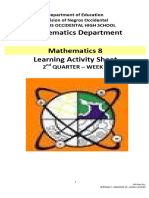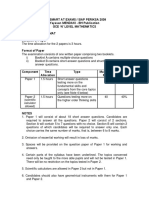Math 8 PLPcot 2
Math 8 PLPcot 2
Uploaded by
Cristie Burato - BeroyCopyright:
Available Formats
Math 8 PLPcot 2
Math 8 PLPcot 2
Uploaded by
Cristie Burato - BeroyOriginal Title
Copyright
Available Formats
Share this document
Did you find this document useful?
Is this content inappropriate?
Copyright:
Available Formats
Math 8 PLPcot 2
Math 8 PLPcot 2
Uploaded by
Cristie Burato - BeroyCopyright:
Available Formats
Republic of the Philippines
Department of Education
Region VII, Central Visayas
Division of Bohol
City of Tagbilaran
LESSON PLAN IN MATHEMATICS
GRADE: 8 QUARTER: 2 WEEK: 7 DAY: 1
COMPETENCY & Determines the inverse, converse, and contrapositive of an if-then statement
OBJECTIVES (M8GE-IIg-1).
Define an inverse, converse and contrapositive of a conditional (if-then)
:
statement
Formulate the converse, inverse, and contrapositive of the conditional
statement
CONTENT : Converse, Inverse, and Contrapositive
LEARNING Mathematics 8 Learner’s Module 6, pages 355-357
:
RESOURCES SLM, Quarter 2, Module 7
PROCEDURE : A. Preparation
Routinary activities
Opening Prayer
Checking of the attendance
Recall:
Before we proceed to the lesson proper, let us have a game through Word
Wall Application(https://wordwall.net/about/template/random-cards) as a
review to our previous discussions which is about “Determining the
Relationship Between the Hypothesis and the Conclusion of an If-then
Statement and Transforming a Statement into an Equivalent If-then
Statement”.
Mechanics of the Game: The students will randomly pick a number from the
gift boxes that consists of a given conditional statement. They will identify
the hypothesis and conclusion of the given statement.
1. If Jane studies for her test, then she will pass the exam.
Hypothesis: Jane studies for her test.
Conclusion: She will pass the exam.
2.
Identify the hypothesis and conclusion of each conditional statement.
1. If I study hard, then I will graduate.
2. If I say bad words, then I will be punished.
B. Motivation
Take a look at these statements:
1. If today is Monday, then tomorrow is Tuesday.
2. If tomorrow is Tuesday, then today is Monday.
3. If today is not Monday, then tomorrow is not Tuesday.
4. If tomorrow is not Tuesday, then today is not Monday.
What have you noticed to the given statements?
C. Presentation
The second statement is what we called the converse of the first statement.
The third statement is the inverse of the first statement.
The fourth statement is the contrapositive of the first statement.
D.Discussion/Abstraction
Three statements can be formed from an implication “If p, then q”. These are
its converse, inverse, and contrapositive.
If-then/ Conditional If p, then q
Converse If q, then p
Inverse If not p, then not q
Contrapositive If not q, then not p
E. Exercises
Complete the table by providing the converse, inverse, and
contrapositive of the given if-then form.
Statement If-then form Converse Inverse Contrapositive
A triangle If a polygon is a
has three triangle, then it
sides. has three sides.
F. Generalization
Interchanging the hypothesis and the conclusion of the conditional
statement makes its converse statement.
Negating the hypothesis and the conclusion of a conditional statement
makes its inverse statement.
Negating the hypothesis and the conclusion of the converse statement
makes a contrapositive of the conditional statement.
G. Application
Divide the class into five. The first group will provide a statement which is
not in an if-then form. The second group will give the if-then form from the
statement given by the first group. The third group will supply the converse.
The fourth group will formulate the inverse. And the last group will make
the contrapositive.
H. Evaluation
Directions: Formulate the converse, inverse, and contrapositive of the given
statement below.
Statement If-then form Converse Inverse Contrapositive
Supplementar If two angles
y angles have are
a sum measure supplementary,
of 180 then the sum
degrees. of their
measures is
180 degrees.
I. Agreement/Assignment
Define logically equivalent statements.
You might also like
- Lesson Plan - Converse & InverseDocument9 pagesLesson Plan - Converse & InverseClaire Mae Chasen Donga100% (2)
- QUIZ1 RETAKE AutoRecovered PDFDocument23 pagesQUIZ1 RETAKE AutoRecovered PDFLaurenze SariNo ratings yet
- Prototype-Math8-LP Q2 W6 D1-4Document5 pagesPrototype-Math8-LP Q2 W6 D1-4Monaliza GasqueNo ratings yet
- Grade 8 February 5 - 9 2018Document2 pagesGrade 8 February 5 - 9 2018LAWRENCE MALLARINo ratings yet
- Detailed Lesson PlanDocument8 pagesDetailed Lesson PlanROSE ANNE SIYANG100% (1)
- Math8 Q2 Mod11 DeterminingTheInverseConverseAndContrapositiveOfAnIfThenStatement v2Document23 pagesMath8 Q2 Mod11 DeterminingTheInverseConverseAndContrapositiveOfAnIfThenStatement v2OLIVIA LIRIONo ratings yet
- Semi Detailed Lesson PlanDocument5 pagesSemi Detailed Lesson PlanNikko Patungan100% (1)
- Q2 w7 Converse, Inverse, Contrapositive Statement (LP)Document6 pagesQ2 w7 Converse, Inverse, Contrapositive Statement (LP)Ram BoncodinNo ratings yet
- Week 8 - Q2 - Math 8Document11 pagesWeek 8 - Q2 - Math 8Jennilyn Salih AnogNo ratings yet
- Mathematics 8 - Module 6Document5 pagesMathematics 8 - Module 6Brylle Epemar CelestialNo ratings yet
- G8DLL Q2W8 LC36-37Document8 pagesG8DLL Q2W8 LC36-37Chan Chanielou Javier100% (1)
- Mathematics: Grade 8 Daily Lesson Log School Grade Level Teacher Learning Area Teaching Dates and Time QuarterDocument12 pagesMathematics: Grade 8 Daily Lesson Log School Grade Level Teacher Learning Area Teaching Dates and Time QuarterMarvin MalicdemNo ratings yet
- 2-New JANUARY-24,2022-DEMO-DLP-REASONING (IF-THEN STATEMENT)Document6 pages2-New JANUARY-24,2022-DEMO-DLP-REASONING (IF-THEN STATEMENT)Angela Camille PaynanteNo ratings yet
- Math8 Q2 Mod11 DeterminingTheInverseConverseAndContrapositiveOfAnIfThenStatement V4-1Document22 pagesMath8 Q2 Mod11 DeterminingTheInverseConverseAndContrapositiveOfAnIfThenStatement V4-1Keziah LapojaNo ratings yet
- Lesson Plan - ContrapositiveDocument9 pagesLesson Plan - ContrapositiveClaire Mae Chasen DongaNo ratings yet
- G8DLL Q2W7 LC35-36Document11 pagesG8DLL Q2W7 LC35-36Lydel L. LawasNo ratings yet
- G8DLL - Q2W7 For CODocument4 pagesG8DLL - Q2W7 For COMark Kiven MartinezNo ratings yet
- Inverse Converse and ContrapositiveDocument4 pagesInverse Converse and ContrapositiveKyla CarbaquilNo ratings yet
- Q2 Mathematics 8 - Module 5Document22 pagesQ2 Mathematics 8 - Module 5Jose Carlos FernandezNo ratings yet
- DLP G-8Document5 pagesDLP G-8ghoul ciprianoNo ratings yet
- Math8 Q2 SLM WK7Document8 pagesMath8 Q2 SLM WK7Shiera SaletreroNo ratings yet
- Conditional StatementDocument8 pagesConditional Statementapi-313517608No ratings yet
- #: :text Our Converse Statement Would Be, Then It Is NOT Raining."Document7 pages#: :text Our Converse Statement Would Be, Then It Is NOT Raining."Arvin Jay MilloNo ratings yet
- G8DLL Q2W8 LC36-37Document8 pagesG8DLL Q2W8 LC36-37Joemard FranciscoNo ratings yet
- Transforming A Statement Into Conditonal Converse Inverse and Contrapositive StatementDocument6 pagesTransforming A Statement Into Conditonal Converse Inverse and Contrapositive StatementAlbert Cipriano100% (1)
- Ralph Rexor M. Bantugan Noah Justine C. SaysonDocument5 pagesRalph Rexor M. Bantugan Noah Justine C. SaysonRalph Rexor Macarayan BantuganNo ratings yet
- Q2W7Math8 q2 Mod9 Reasoning v3Document17 pagesQ2W7Math8 q2 Mod9 Reasoning v3Elise Maxine BenavidesNo ratings yet
- Converse Inverse and Contrapositive CO2 2023 2024Document8 pagesConverse Inverse and Contrapositive CO2 2023 2024Joric SisonNo ratings yet
- Lesson Plan Grade 8 With LUMI ApplicationDocument5 pagesLesson Plan Grade 8 With LUMI ApplicationJerry BasayNo ratings yet
- Genesis Limoico Lesson ExemplarDocument2 pagesGenesis Limoico Lesson ExemplarNoci Nusa OciomilNo ratings yet
- Detailed Lesson Plan (Inverse, Converse and Contrapositive)Document10 pagesDetailed Lesson Plan (Inverse, Converse and Contrapositive)allynvencito6No ratings yet
- G8DLL Q2W8 LC36-37Document9 pagesG8DLL Q2W8 LC36-37Marvin MalicdemNo ratings yet
- DAILY LESSON LOG Demo QDocument3 pagesDAILY LESSON LOG Demo Qmark lan torresNo ratings yet
- 1 M8GE-IIF-1 If Thenstatement RelationshipsDocument2 pages1 M8GE-IIF-1 If Thenstatement RelationshipsMhel Ann CastinoNo ratings yet
- COT1 Math 8Document5 pagesCOT1 Math 8Marvin Jay LulabNo ratings yet
- G8 - e - Lesson 13Document48 pagesG8 - e - Lesson 13Resy VillanuevaNo ratings yet
- G8 Geomtrigo Q1 M4Document23 pagesG8 Geomtrigo Q1 M4ARIEL V. ABANESNo ratings yet
- UntitledDocument7 pagesUntitledArvin Jay MilloNo ratings yet
- Math8 Q2 SLM WK6Document11 pagesMath8 Q2 SLM WK6Shiera SaletreroNo ratings yet
- Lesson Plan - If-Then StatementDocument11 pagesLesson Plan - If-Then StatementClaire Mae Chasen Donga100% (2)
- Grade 8 Mathematics SecondDocument3 pagesGrade 8 Mathematics SecondFlorita LagramaNo ratings yet
- UntitledDocument8 pagesUntitledArvin Jay MilloNo ratings yet
- Dlp-Conditional StatementsDocument7 pagesDlp-Conditional StatementsJanene Federico100% (1)
- UntitledDocument8 pagesUntitledArvin Jay MilloNo ratings yet
- Lesson Plan in Mathematics 8 2nd QuarterDocument4 pagesLesson Plan in Mathematics 8 2nd Quartermarvelyn.dulpinaNo ratings yet
- Q2_Week6_LAS_Inverse_Converse_Contrapositive_Of_An_If_Then_StatementDocument11 pagesQ2_Week6_LAS_Inverse_Converse_Contrapositive_Of_An_If_Then_StatementalexandrabbasaNo ratings yet
- Q2_Week5_LAS_CONDITIONAL-STATEMENTSDocument10 pagesQ2_Week5_LAS_CONDITIONAL-STATEMENTSalexandrabbasaNo ratings yet
- G8 Geomtrigo Q1 M2Document19 pagesG8 Geomtrigo Q1 M2ARIEL V. ABANESNo ratings yet
- Detailed Lesson Plan (Inductive & Deductive)Document8 pagesDetailed Lesson Plan (Inductive & Deductive)allynvencito6No ratings yet
- Revalidated - MATH - GR8 - QTR2-MODULE-9 (28pages)Document28 pagesRevalidated - MATH - GR8 - QTR2-MODULE-9 (28pages)RAYMOND MAGADIANo ratings yet
- DLLinGeoClassDRationalGroup FinaldocsDocument3 pagesDLLinGeoClassDRationalGroup FinaldocsEfren Aguatani Jr.No ratings yet
- Lesson Plan TLL PRBLDocument6 pagesLesson Plan TLL PRBLangeljophanieaNo ratings yet
- 7 - Q2 Gen MathDocument22 pages7 - Q2 Gen Mathkeithyanyan0No ratings yet
- Relationship Between The Hyphothesis and The Conclusion of An If-Then StatementDocument33 pagesRelationship Between The Hyphothesis and The Conclusion of An If-Then Statementkennethvilla07No ratings yet
- CLEAR - Q2 - Math 8 - Week 6Document8 pagesCLEAR - Q2 - Math 8 - Week 6Maria Liza CamoNo ratings yet
- Math8 Q2 SLM WK8Document10 pagesMath8 Q2 SLM WK8Shiera SaletreroNo ratings yet
- Elective Mathematics 8 Module 1 3rd Quarter FInalDocument18 pagesElective Mathematics 8 Module 1 3rd Quarter FInalPrincess Bella Ubas100% (1)
- DLP Math 8.2Document6 pagesDLP Math 8.2Val Daryl AnhaoNo ratings yet
- Lesson Plan - Truth ValueDocument9 pagesLesson Plan - Truth ValueClaire Mae Chasen DongaNo ratings yet
- Milliken's Complete Book of Instant Activities - Grade 2: Over 110 Reproducibles for Today's Differentiated ClassroomFrom EverandMilliken's Complete Book of Instant Activities - Grade 2: Over 110 Reproducibles for Today's Differentiated ClassroomRating: 4 out of 5 stars4/5 (1)
- G9 GeometryDocument106 pagesG9 GeometrymiwoocyaNo ratings yet
- Triangles Practice Set 3.4 Maharashtra BoardDocument17 pagesTriangles Practice Set 3.4 Maharashtra BoardKrako TramNo ratings yet
- Lecture 1 Building StructuresDocument39 pagesLecture 1 Building StructuresLee MingNo ratings yet
- SSC CGL Exam Pattern and Syllabus 2023Document31 pagesSSC CGL Exam Pattern and Syllabus 2023amitkumarminz363255No ratings yet
- Triangles Objective QuestionsDocument6 pagesTriangles Objective Questionsnemiw25651No ratings yet
- Unit IDocument10 pagesUnit Isingani09No ratings yet
- Simple Curves MATHalinoDocument10 pagesSimple Curves MATHalinodurdantahalder10No ratings yet
- Mensuration-Maths Project WorkDocument11 pagesMensuration-Maths Project WorkJay Shukla38% (8)
- Maths in DanceDocument16 pagesMaths in Danceapi-385746668100% (3)
- Ncert Solutions For Class 8 Maths Chapter 2Document20 pagesNcert Solutions For Class 8 Maths Chapter 2Rishabh KumarNo ratings yet
- IX TermII-TTandPortionSheet 2mmejfehcudb599Document8 pagesIX TermII-TTandPortionSheet 2mmejfehcudb599Srishti and Amayra's CREATIVITYNo ratings yet
- JEE Main Adv Class XIII275941779Document33 pagesJEE Main Adv Class XIII275941779Shashin VyasNo ratings yet
- Yjc H2 Math P1Document6 pagesYjc H2 Math P1jimmytanlimlongNo ratings yet
- One Stop For Colleges Education Career: Minglebox e-CAT PrepDocument11 pagesOne Stop For Colleges Education Career: Minglebox e-CAT PrepVashishta VashuNo ratings yet
- CSEC Maths 2024 June Past Paper SolutionsDocument50 pagesCSEC Maths 2024 June Past Paper SolutionsAdrianna SealeyNo ratings yet
- Delhi Public School: Sail Township, RanchiDocument4 pagesDelhi Public School: Sail Township, RanchiVikash MalhotraNo ratings yet
- FG 201813Document4 pagesFG 201813Fustei Bogdan100% (1)
- GR 1 Math Chapter 5-7 (Pages 68-109)Document42 pagesGR 1 Math Chapter 5-7 (Pages 68-109)tizitamasresha70No ratings yet
- KSF 2021 - Student (S) : 3 Points ProblemsDocument4 pagesKSF 2021 - Student (S) : 3 Points ProblemsVijayata AggarwalNo ratings yet
- Exercise 2Document3 pagesExercise 2Fake GuyNo ratings yet
- D.A.V Public School, Sec-49 SESSION 2015-16 Maths Assignment No. 5 (Triangles) Class IX (Term-1) Name: Roll No.: SectionDocument2 pagesD.A.V Public School, Sec-49 SESSION 2015-16 Maths Assignment No. 5 (Triangles) Class IX (Term-1) Name: Roll No.: SectionSunny BhatiaNo ratings yet
- SAT Rules-Mr - AliDocument12 pagesSAT Rules-Mr - AliOsman AhmadovNo ratings yet
- KSF 2016 Ecolier: 3 Point ProblemsDocument6 pagesKSF 2016 Ecolier: 3 Point ProblemsAnonymous fo6Ii97fNo ratings yet
- Real Madrid Coaching NotesDocument17 pagesReal Madrid Coaching NotesCoach Ryan RoyNo ratings yet
- DLP 33Document6 pagesDLP 33Pablo JimeneaNo ratings yet
- Aisse/Aissce Common Mock ExaminationDocument10 pagesAisse/Aissce Common Mock ExaminationPious PrinceNo ratings yet
- Triangles Homothetic With The Intouch TriangleDocument6 pagesTriangles Homothetic With The Intouch TriangleAlexander MarinovNo ratings yet
- GCE N Level Math 2009 FullDocument13 pagesGCE N Level Math 2009 FullpigamiNo ratings yet
- LESSON PLAN PerimeterDocument6 pagesLESSON PLAN Perimeterannarose bongcayaoNo ratings yet

























































































